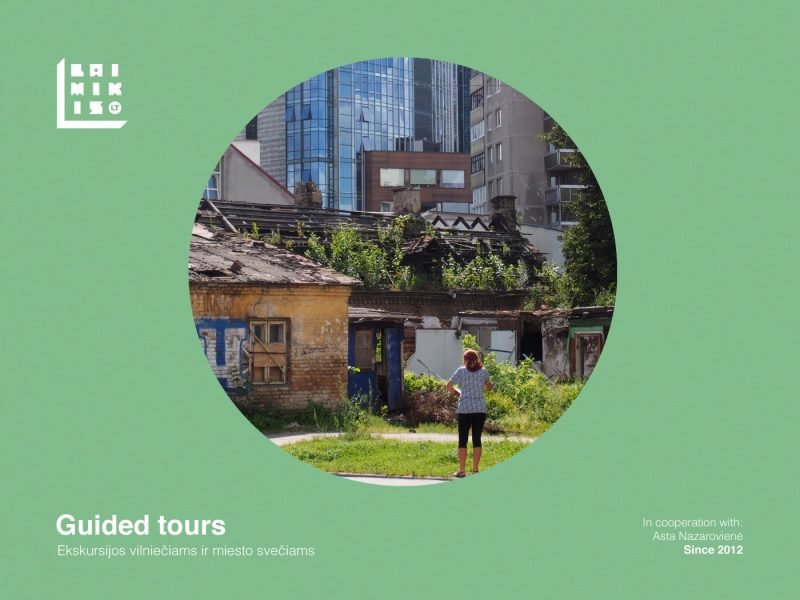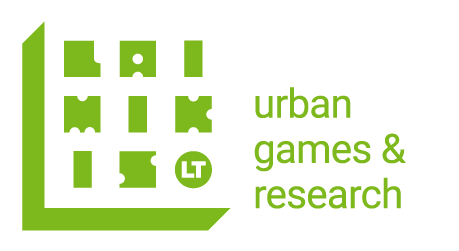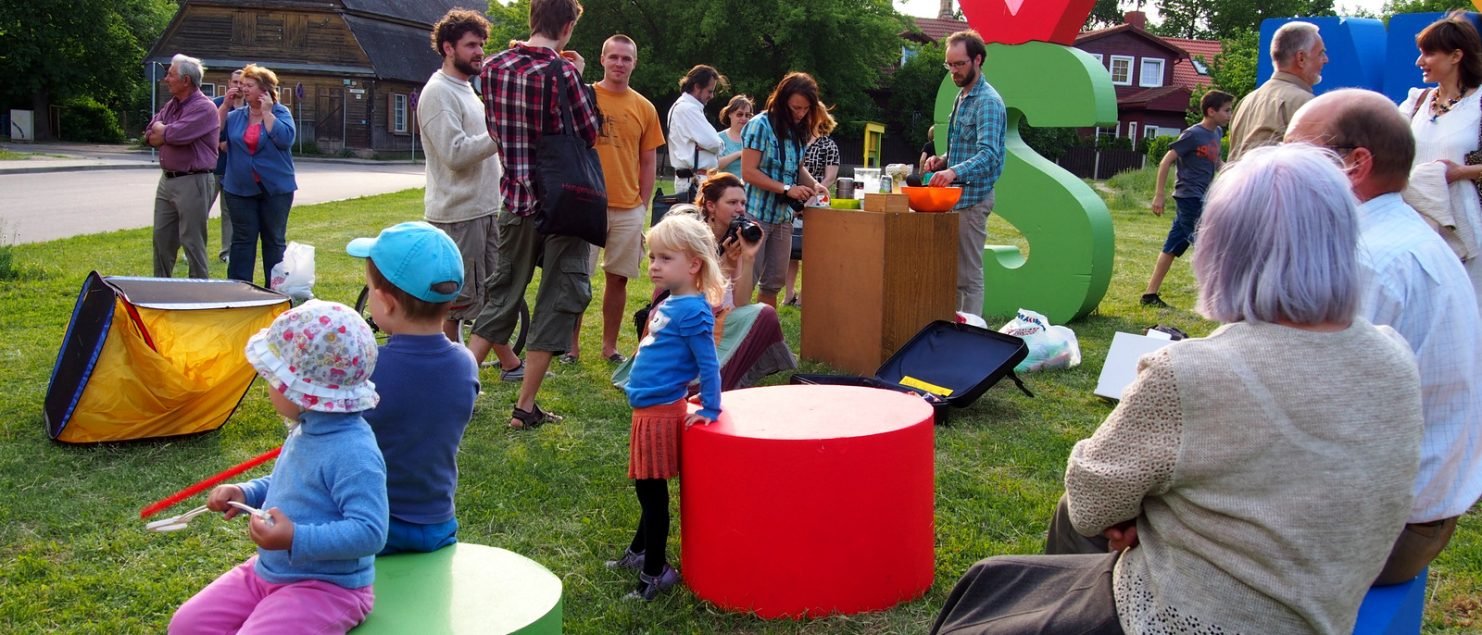Action research and placemaking in Šnipiškės (timeline)
Our placemaking journey and action-based research in the historic Šnipiškės neighbourhood started in 2012 and has already spanned a decade. The process embraces the following stages:
Desk-research & field research » Creative communication and placemaking tools » Participatory design-based research and arts-based research » Cooperatively developed cultural routes, developed public space (Dragon’s field), adjusted image of the neighbourhood » Educational activities for visiting artists, researchers, students and other groups » Publications, exhibitions, interviews.
2012 – We examined the cultural potential (including mapping the unique architectural elements, the neighbourhood’s colour palette and other elements essential for the local identity). Examined dominating image (media content analysis). Explored social background (during the design-based research phase) and studied the use of the wooden Šnipiškės territory – flows of people, points of attractions, and places for contact between inhabitants. We have identified challenges in the area, which include a lack of community, a lack of a shared vision for the future of the neighbourhood, a lack of public spaces where social cooperation between the residents could grow; a lack of basic infrastructure and a lack of funds that would support residents to restore their wooden houses. We have identified the hot spots in the neighbourhood where the most social contacts happen or may happen. We identified the plots that may become public spaces and contacted Šnipiškės leadership to get the permissions for future actions.

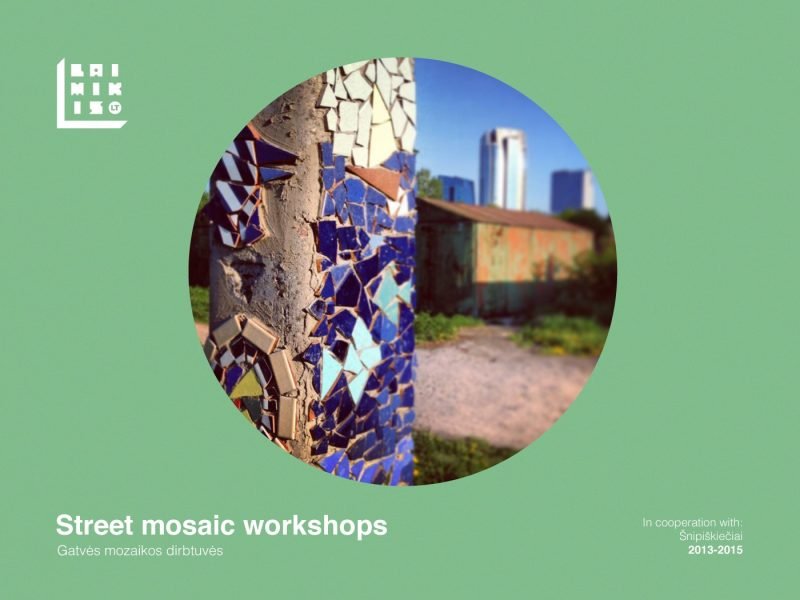
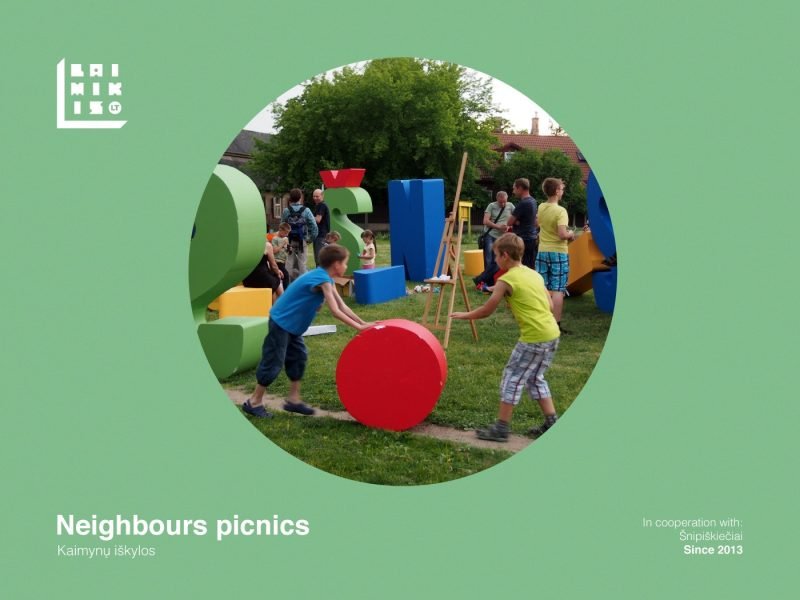
2013 – Laimikis team installed notice boards at the identified hot spots and renewed a neglected notice board on Fino Street. During this onsite activity, we made first contact with the local inhabitants. Laimikis and the inhabitants started using the notice boards, proposing various topics for consideration and discussion. Facebook group Šnipiškiečiai is launched. For several years after we installed notice boards, we ran parallel online and offline communication to include as many inhabitants as possible. In 2022, the installed board at the Dragon’s Field was renewed by the local artist Pijus.
• Drawing upon the findings during the desk research concerning the district’s history, the Street Mosaics Workshop was launched, and the mosaics route was developed in cooperation with the local inhabitants, especially local children.
• The first neighbours’ picnic was arranged in one of the identified potential public spaces. We have designed a module urban furniture set consisting of the letters “ŠNIPIŠKĖS” as a placemaking set and for representational purposes during community gatherings in public spaces.
• Because neighbours’ picnics have become regular, we proposed that inhabitants choose the name for the revitalised public space, and most of the preferences were for the name of the Dragon’s Field. Later, we had to defend this name at the municipality’s “memory commission”. Dragon’s field name was officially registered in municipal documents.
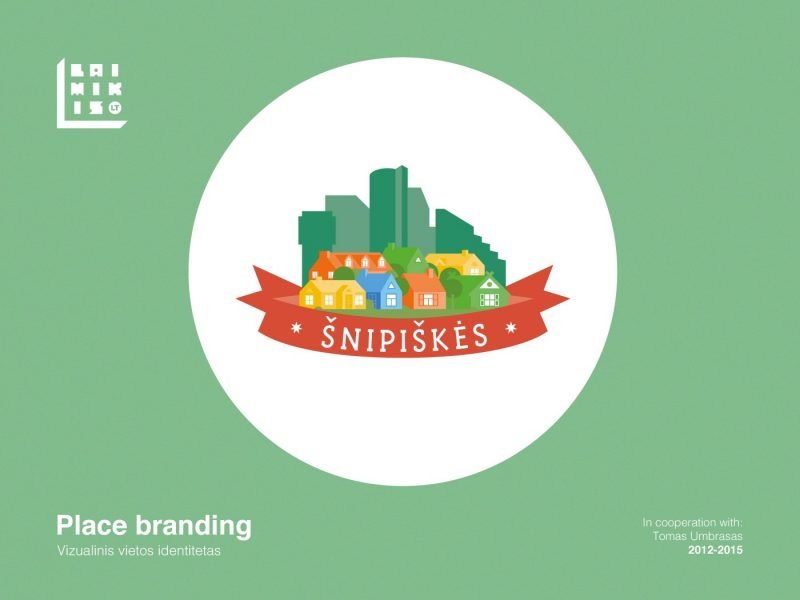 • Drawing on the results of mapping the elements and traits crucial to the identity of the district, in cooperation with the designer Tomas Umbrasas, a visual identity pack for Šnipiškės communication was created, used for the layouts of the notice boards, Facebook group, flyers and newsletters, and further installations in the public space.
• Drawing on the results of mapping the elements and traits crucial to the identity of the district, in cooperation with the designer Tomas Umbrasas, a visual identity pack for Šnipiškės communication was created, used for the layouts of the notice boards, Facebook group, flyers and newsletters, and further installations in the public space.
•• As a part of the “InterContexts” network, our activities in Šnipiškės were acknowledged as the European Star project.
2014 – We created, tested and patented the urban game “Urbingo”, which promotes the districts’ local heritage – architecture and everyday culture. The very 1st version of the game was devoted to Šnipiškės wooden heritage. This game was created based on the photo archive of urban elements and panoramas, which are essential for the character of the historic area. Inhabitants contributed to the photo archive. Since then, Laimikis has arranged this game in Šnipiškės by request.
2014-2016 – Continued: neighbours picnics at the Dragons field, use of the placemaking set, Street Mosaics Workshop. Started: walks in Šnipiškės by Asta Nazarovienė. Asta knows many peculiar details about the area’s lifestyle as a local. We strongly support the idea that locals should run the excursions and benefit from the cultural activities in the historic neighbourhoods. Local narratives belong to the local people. Jekaterina Lavrinec runs study visits in Šnipiškės for visiting researchers and artists.

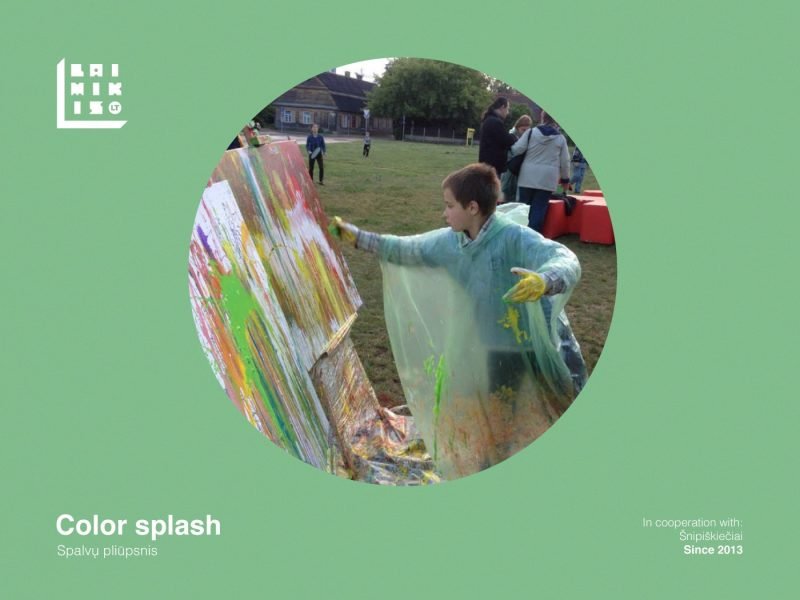

2015 – Continuing the placemaking program for the public spaces in the neighbourhood, Laimikis ran Co-design workshops in 4 Vilnius neighbourhoods (Šnipiškės among them), during which we created and tested another placemaking set, Tetris-like “Open code urban furniture“, in each participating neighbourhood. The co-design workshop is the outcome of the design-based research conducted by Jekaterina Lavrinec (CDC grant). Many thanks to Miroslavas, Asta, Artur and Kamilis for help, and we had many helpers among local kids who started arranging events for other resident groups :)
2016 – Because the attempt to establish the owners’ association failed with the inhabitants, we started developing a participatory economic model for the historic neighbourhood. We mapped the scenarios for using the property based on what the owners proposed (excursions, open-air cafes, workshops, souvenir shops). The whole neighbourhood can work as a spatial network of interconnected services. As a key speaker at the annual European Community Centres Forum, dr. Jekaterina Lavrinec presented the developed methodology and collected alternative models used in the UK, Germany and Spain (TEH83: Sharing Communities, ROJC, Pula, Croatia, 2017). It was also presented at a series of seminars in Brussels and Vilnius (including Urbact 2017).
• In cooperation with locals, Laimikis group applies to the Vilnius municipality to establish two public spaces in the neighbourhood (Dragon’s Field and the “Saracens’ pocket park” – the latter name is just a working version) and go through the process of including two public spaces in the planning documents. We are grateful for the “No Architects” consultancy!
2016-2018 – Laimikis cooperates with Vilnius University, Department of Geography and Land Management; prof. Dovilė Krupickaitė and dr. Jekaterina Lavrinec runs annual field research sessions for MA students in geography and land management. The research results are presented to the Department of Development at Vilnius municipality. Among the topics developed by the MA student groups are the identity of the area, green spaces and plants, use of the public spaces, transport and pedestrian links, and monitoring the condition of the wooden heritage.
2017 – Conducted research on the materiality of the historical neighbourhood “Wood, Concrete, Glass” (partly commissioned by Vilnius municipality) and developed the Dispatchwork concept. Prepared and opened the exhibition devoted to the wooden Šnipiškės for the Bi-city biennale of urbanism and architecture (Shenzhen, China).
• Laimikis established cooperation agreements with the educators of the National Arts Gallery and the Energy and Technology museums in the Šnipiškės district. We see that these institutions can contribute to the historic neighbourhood, and the connections between the residents and the museums can be more active.
2018 – By the Energy and Technology Museum call, the Laimikis team participated in the public exhibition “Explore Šnipiškės”. We presented a public lecture on the participatory revitalisation of this area [more in Lithuanian].
2019-2021 – Laimikis cooperates with Vilnius TECH Department of Creative Industries to develop “Urban Cultural Planning” (Interreg BSR) in the part of Šnipiškės with multistore houses, built in the late 60’s. Together, we mapped the area’s potential, created new cultural routes and the botanic game for the district, held workshops with seniors and children, and implemented placemaking initiatives. Previously developed activities in the wooden part of the district are included in the project’s showcases.
2021-2024 – Laimikis continues running study visits to the wooden Šnipiškės for artists, students, and research groups working in urban planning, architecture, preservation and restoration, creative industries, cultural management, etc. Partners: Inholland University of Applied Sciences, Rupert, Vilnius TECH Faculty of Creative Industries, Vilnius TECH Faculty of Architecture, University of Virginia, University of Turku, etc.
2024 – In cooperation with NTNU, Turku University Landscape Study Group and Vilnius TECH Faculty of Creative Industries, our team examines circular knowledge of the residents of the wooden neighbourhoods in Trondheim, Pori and Vilnius (Šnipiškės). Description of the project | Project site.


